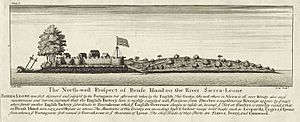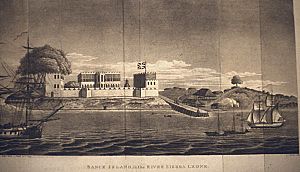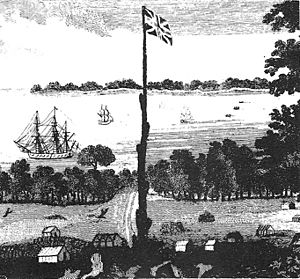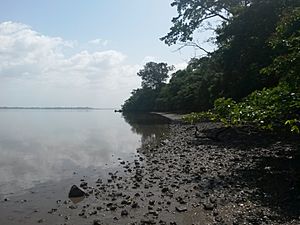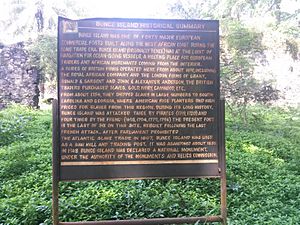Bunce Island facts for kids

A satellite picture of Freetown, 2006.
|
|
| Geography | |
|---|---|
| Location | Sierra Leone River |
| Coordinates | 8°34′N 13°02′W / 8.567°N 13.033°W |
| Administration | |
| Additional information | |
| Time zone |
|
Bunce Island is a small island located in the Sierra Leone River in West Africa. It sits in Freetown Harbour, about 20 kilometers (12 miles) upriver from Freetown, the capital city of Sierra Leone. The island is quite small, measuring about 500 meters (1650 feet) long and 100 meters (350 feet) wide.
On Bunce Island, you'll find the ruins of a castle built around 1670 by a British company. This castle was a major center for the Atlantic slave trade. Sadly, tens of thousands of Africans were forced into slavery and shipped from here to the North American colonies, especially South Carolina and Georgia. Many African Americans today are descendants of people who were taken from this region.
Even though the island is small, its location was very important. It was at the point where large ships could no longer sail further up the river. This made it a perfect spot for European slave traders. To remember the 200th anniversary of Britain ending the slave trade (in 2007-2008), a team from James Madison University created a 3D animation of the castle as it looked in 1805. This animation was shown in museums across the U.S. and is now at the Sierra Leone National Museum.
Contents
History of Bunce Island
English slave traders first settled and built defenses on Bunce Island around 1670. In its early days, the castle was run by two companies from London: the Royal African Company and a related company called the Gambia Adventurers. These companies were supported by the British Crown.
The castle wasn't always a big money-maker, but it showed that England had a presence in the area. Portuguese slave traders had been active there since the 1500s. The first period of the castle's history ended in 1728. A powerful local slave trader named José Lopez da Moura attacked Bunce Island and destroyed the trading post. He was a very rich man in Sierra Leone, and his family had both African and Portuguese roots. He and others like him resisted the British companies trying to control all the trade.
Bunce Island was left empty until the mid-1740s. Later, a new company from London, Grant, Oswald & Company, took over in 1748. This company was founded by Scottish merchants. In 1773, a Swedish scientist visited the island. He wrote about how six members of the company played golf there, with African helpers carrying their clubs.
By 1785, Bunce Island was owned by John and Alexander Anderson's company. It became very profitable in the late 1700s. During this time, thousands of enslaved people were sent from Bunce Island to plantations in the British and French colonies in the West Indies, and to British colonies in North America.
The main building on the island was Bance Island House. This was where the chief manager and his officers lived. Right behind it was an open-air yard where enslaved people were held. This yard was divided into areas for men, and smaller areas for women and children. Today, you can still see parts of two watchtowers, a fort with places for eight cannons, and a gunpowder magazine. Some of the cannons have the symbol of King George III. At the south end of the island, there are gravestones for slave traders and ship captains.
The slave traders who worked at Bunce Island came from different backgrounds. In the early days, people of mixed African and Portuguese heritage sold enslaved people and local goods there. These people were often bilingual and acted as go-betweens. Later, mixed-race families with British and African roots became important. Men from families like the Caulkers and Tuckers also sold enslaved people and traded goods at Bunce Island.
Slave ships came from cities like London, Liverpool, and Bristol in Britain. They also came from Newport, Rhode Island in the North American colonies, and from France and Denmark. These ships mostly transported enslaved people to European colonies in the Caribbean and the American South.
Bunce Island was a valuable British trading post, so it was often attacked during wars. French naval forces attacked the castle four times (in 1695, 1704, 1779, and 1794). Each time, they damaged or destroyed it. The attack in 1779 happened during the American Revolutionary War, when France (an ally of the American colonists) attacked British sites outside North America. Pirates, including the famous Bartholomew Roberts ("Black Bart"), also attacked the island in 1719 and 1720. The British traders rebuilt the castle after each attack, changing its design over the 140 years it was used for the slave trade.
Bunce Island's Links to North America

Bunce Island is especially known as a main place where enslaved people were processed before being sold to plantation owners in South Carolina and Georgia. These colonies, especially the Sea Islands, had many rice plantations. Growing rice successfully needed a lot of special knowledge. Planters in South Carolina and Georgia were willing to pay high prices for enslaved workers from what they called the "Rice Coast" of West Africa. This area, stretching from Senegal to Liberia, was known for rice farming. However, records show that almost 40% of enslaved people arriving in Charleston came from Angola.
Bunce Island was the largest British slave castle on the Rice Coast. African farmers who knew how to grow rice were often kidnapped from inland areas. They were then sold at the castle or at smaller trading posts along the coast, before being shipped to North America. Thousands of enslaved people from Bunce Island were taken to the ports of Charleston and Savannah in the late 1700s. Advertisements for slave auctions in these cities often mentioned ships arriving from "Bance" or "Bense" Island.
An American colonist named Henry Laurens was the business agent for Bunce Island in Charleston. He was a rich plantation owner and slave trader. He later became the President of the Continental Congress during the American Revolutionary War. He was also a U.S. envoy to the Netherlands. During the war, he was captured by the British and put in the Tower of London. After the war, he helped negotiate the Treaty of Paris, which gave the United States its independence. The main British negotiator was Richard Oswald, who was a principal owner of Bunce Island. He and Laurens had been friends for 30 years.
Bunce Island also had connections to the Northern colonies in America. Slave ships from northern ports often stopped at Bunce Island. They would get fresh water and supplies for the trip across the Atlantic. They also bought enslaved people to sell in the British islands of the West Indies and the Southern Colonies. These North American slave ships came from places like Newport, New London, Salem, and New York City.
The Decline of Bunce Island
In 1787, British groups who wanted to help freed slaves started a settlement called Granville Town. It was on the Sierra Leone Peninsula, about 20 kilometers (12 miles) downriver from Bunce Island. This first attempt to create a colony for freed slaves didn't work out. But in 1792, the city of Freetown was founded. This became the permanent Colony of Sierra Leone. The Atlantic slave trade itself continued to be legal for another 20 years.
In 1807, the British parliament voted to abolish the slave trade. The next year, Freetown became a British Crown colony. The Royal Navy set up its Africa Squadron there. They regularly patrolled the waters to find slave ships that were breaking the new law. Bunce Island stopped being used for slave trading. British companies tried to use the castle as a cotton plantation, a trading post, and a sawmill. But these businesses were not successful. The island was abandoned around 1840. After that, the buildings and stone walls slowly fell apart.
Research on Bunce Island
Three American scholars have studied Bunce Island. Anthropologist Joseph Opala found links between the island and the Gullah people of the United States Low Country. He helped organize "homecomings" for Gullah people, which were shown in documentary films. Historian David Hancock wrote about Bunce Island during the time of Grant, Oswald & Company.
In 2006, actor Isaiah Washington visited the island. He learned through a DNA test that he was descended from the Mende people of Sierra Leone. Washington later gave money to a project to create a computer model of Bunce Island as it looked in 1805. This was to mark the 200th anniversary of the end of the African slave trade by the UK and the United States.
Project directors Joseph Opala and Gary Chatelain at James Madison University used computer design and old drawings to create a 3D image of the castle. This image is part of an exhibit that tells the island's history and shows how the buildings looked 200 years ago.
Many historical and family links have been found between Bunce Island and the United States. In 2013, historians discovered that two U.S. presidents, George H. W. Bush and George W. Bush, are direct descendants of a slave ship captain. This captain, Thomas Walker, operated out of Bunce Island and other ports in Sierra Leone in the late 1700s. He was involved in 11 slave trading trips. He later moved to the U.S. and became a citizen. One of his descendants was Dorothy (Walker) Bush, the mother of George H.W. Bush.
Protecting Bunce Island
In 1948, Bunce Island became Sierra Leone's first officially protected historic site. In the same year, a Sierra Leonean doctor and historian named M.C.F. Easmon led a trip to clear plants, map the ruins, and take the first photos. Research on the island has been ongoing since the 1970s. A hurricane in 1974 damaged some of the structures.
Today, Bunce Island is protected by the Sierra Leonean Monuments and Relics Commission. This group is part of the country's Ministry of Tourism and Culture. The government is working to save the castle as an important historic site and a place for tourists to visit, especially African Americans. Bunce Island has been called "the most important historic site in Africa for the United States." This is because thousands of enslaved people were shipped from here to ports in the American South. Gorée Island in Senegal is more famous than Bunce Island. It has attracted African-American tourists and support for preservation since the 1980s.
In October 2010, a group called the Bunce Island Coalition (US) and its local partner announced the Bunce Island Preservation Project. This was a five-year, $5 million effort. Its goal was to preserve the castle ruins and build a museum in Freetown. The museum would tell the island's history and explain the impact of the Atlantic slave trade in Sierra Leone.
Notable Visitors
General Colin Powell, who was then the Chairman of the US Joint Chiefs of Staff, visited Bunce Island in 1992. He was on an official trip to Sierra Leone. In a speech before he left, Powell spoke about his feelings: "I am an American...but today, I am something more...I am an African too...I feel my roots here in this continent."
Climate
Like the rest of Sierra Leone, Bunce Island has a tropical climate. There are two main seasons that affect farming. The rainy season lasts from May to November. The dry season is from December to May. During the dry season, cool, dry winds called harmattan blow in from the Sahara Desert. At night, the temperature can drop to about 16°C (61°F). The average temperature is about 26°C (79°F). It usually ranges from 26°C to 36°C (79°F to 97°F) throughout the year.
See also
 In Spanish: Isla Bunce para niños
In Spanish: Isla Bunce para niños



